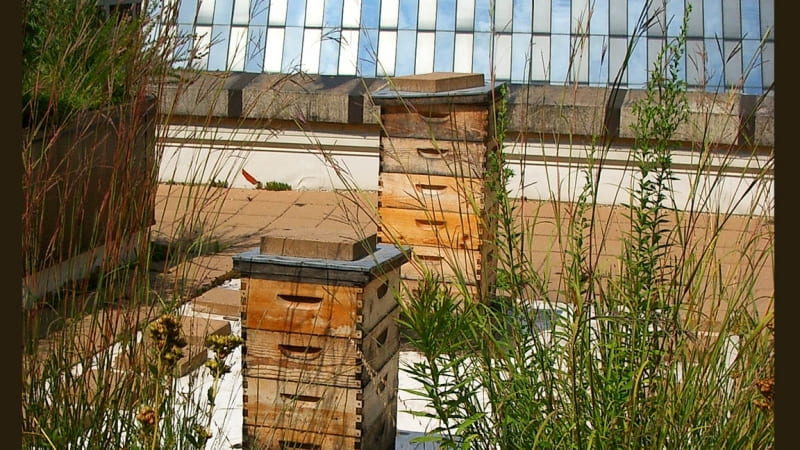WON’T YOU BEE MY NEIGHBOR?: PART 2
By: Hannah Gavin

These apiaries, or beehives, are perched on top of City Hall in downtown Chicago. Image sourced from Wikimedia and used under Creative Commons.
(Missed the first of Hannah Gavin’s bee blogs? Catch-up here.)
“What are we doing on bees? Are we doing enough?” ~ US President Barack Obama
How much time do you spend thinking about bees? I’m guessing any attention they do get is relegated to those occasions when a buzz, and the associated threat of pain, disrupts a summer picnic or a tranquil lounge by the pool. Would you be surprised to know, then, that bees are garnering regular attention from some powerful people…people like the President of the United States?
It might seem strange to imagine the besuited residents of the Oval Office huddled over a document concerning small black and yellow bugs. In fact, there are intimate connections between the health of bees and the health of the US economy, justifying the attention!
By pollinating plants, bees facilitate production of an estimated $15 billion in US crops. Sadly, these unsung insect heroes are struggling; bee populations have suffered alarming declines since 2006. Each year more than 40 percent of colonies maintained by beekeepers die off. This phenomenon, called Colony Collapse Disorder (CCD), is a threat to bees and, in turn, to the American food supply. Current research in the field has not been able to pinpoint one specific cause for CCD, but reports indicate that bees have been bombarded by numerous insults including climate change, pesticide use, and insect pathogens.
In June 2014, the president called for a Strategy to Promote the Health of Honey Bees and Other Pollinators. The resulting document and accompanying science-based Pollinator Research Action Plan were released in May 2015. The Strategy defines current and planned Federal-level actions to directly support the health of honeybees and another important pollinator, the Monarch butterfly, through four major aims:
- Encourage research to better understand factors negatively impacting pollinator populations (is it pesticides? climate change? disease?).
- Expand public outreach programs so citizens are educated about pollinators (bats, butterflies, and bees…oh my!).
- Expand and improve habitats in which pollinators can thrive (more land, please).
- Partner across various organizations both public and private to achieve each of the aforementioned goals.
The corresponding Action Plan then used current data on pollinators to identify key knowledge gaps, outline priority actions and assign government agencies to work on each of the priority actions.
How are we doing 6 months after the release of the Pollinator Research Action Plan? That remains to be seen. The first annual progress reports won’t be published until spring of 2016. (Watch this space for updates.)
In the meantime, farmers and presidents alike are calling for an educated and involved public. So how can we learn and do more? As it turns out, cities are hubs of education and pro-pollinator activity. According to the Chicago Botanic Garden, simply adding sunflowers or milkweed to our porches and community garden plots can make these spots better feeding sources for pollinators. Urban beekeeping in cities has taken flight, too; apiaries (or collections of beehives) are cropping up at the White House and on Chicago rooftops, including City Hall. Novice beekeeping-enthusiasts can take classes through the Chicago Honey Co-op or the Garfield Park Conservatory. Butterfly admirers can walk amongst the Monarchs and learn about the elegant insects at the Peggy Notebaert Nature Museum’s Butterfly Haven.
For people unenthused by gardening or hanging out with insects as a hobby (but still want to secure their supply of pollinator-dependent marinara sauce), organizations like the Pollinator Partnership transform monetary donations into support for pollinators.
Whether reading and sharing, gardening and beekeeping, or donating and lobbying, everyone can take steps to secure the future of insects that have long flown under the radar.
